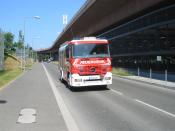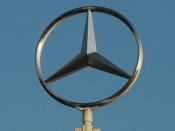Table of ContentsIntroduction3Organizational Size, Life-cycle and Control3Organizational Structure7Cross-functional teams9Recent Product Innovations10Innovation Process11Conclusion14References15IntroductionIn 1998, the merger between US-based Chrysler German-based Daimler Mercedes formed the company known today as DaimlerChrysler. The merger caused rapid growth as well as numerous challenges that the company still needs to overcome. Currently, the organization is in the elaboration phase of organizational growth, marked by the need for revitalization, more efficient decision making, and reducing redundancies in the organizational hierarchy. As it faces merciless competition of the automotive industry, the company is implementing structural changes geared towards making the company more efficient in its day-to-day operations, and allowing it to produce innovative products, thus setting it apart from the competition.
This paper starts out with a discussion of DaimlerChrysler's current phase of organizational development and some of the key challenges that the company is facing today, followed by a discussion of recent organizational structure changes aimed at overcoming these challenges.
Next, we describe the use of cross-functional or "innovation" teams and how this approach can reduce organizational deficiencies at DaimlerChrysler. Finally, we conclude with a description of cutting-edge, innovative products that the company has produced recently, and the process of managing innovation and creativity at DaimlerChrysler.
Organizational Size, Life-cycle and ControlIn 1998, DaimlerChrysler was formed as a result of the merger between Chrysler and Daimler-Benz, even though many stockholders did not wanted the merger to take place because Chrysler was not meeting its financial goals with its line of vehicles. These stockholders believed that the merger will further devaluate the stock. So Chrysler was faced with the internal problem of meeting profitability goals and not going out of business, as well as the external problem of many of the company's stockholders opposing the proposed merger (Wikipedia.org, 2006).
Right after the Daimler-Benz and Chrysler...


